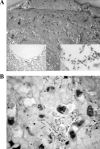Detection and toxin typing of Clostridium perfringens in formalin-fixed, paraffin-embedded tissue samples by PCR
- PMID: 19109478
- PMCID: PMC2650962
- DOI: 10.1128/JCM.01324-08
Detection and toxin typing of Clostridium perfringens in formalin-fixed, paraffin-embedded tissue samples by PCR
Abstract
Since current microbiology methods are not suitable to detect Clostridium perfringens in formalin-fixed, paraffin-embedded tissue samples, we developed a PCR assay to detect toxin-encoding genes and the 16S rRNA gene of C. perfringens. We successfully detected and genotyped C. perfringens in tissue sections from two autopsy cases.
Figures



References
-
- Awad, M. M., A. E. Bryant, D. L. Stevens, and J. I. Rood. 1995. Virulence studies on chromosomal alpha-toxin and theta-toxin mutants constructed by allelic exchange provide genetic evidence for the essential role of alpha-toxin in Clostridium perfringens-mediated gas gangrene. Mol. Microbiol. 15191-202. - PubMed
-
- Bentancor, A. B., M. R. Fermepin, L. D. Bentancor, and R. A. de Torres. 1999. Detection of the etx gene (epsilon-toxin inducer) in plasmids of high molecular weight in Clostridium perfringens type D. FEMS Immunol. Med. Microbiol. 24373-377. - PubMed
-
- Gkiourtzidis, K., J. Frey, E. Bourtzi-Hatzopoulou, N. Iliadis, and K. Sarris. 2001. PCR detection and prevalence of alpha-, beta-, beta 2-, epsilon-, iota- and enterotoxin genes in Clostridium perfringens isolated from lambs with clostridial dysentery. Vet. Microbiol. 8239-43. - PubMed
-
- Havard, H. L., S. E. Hunter, and R. W. Titball. 1992. Comparison of the nucleotide sequence and development of a PCR test for the epsilon toxin gene of Clostridium perfringens type B and type D. FEMS Microbiol. Lett. 7677-81. - PubMed
MeSH terms
Substances
LinkOut - more resources
Full Text Sources
Molecular Biology Databases

